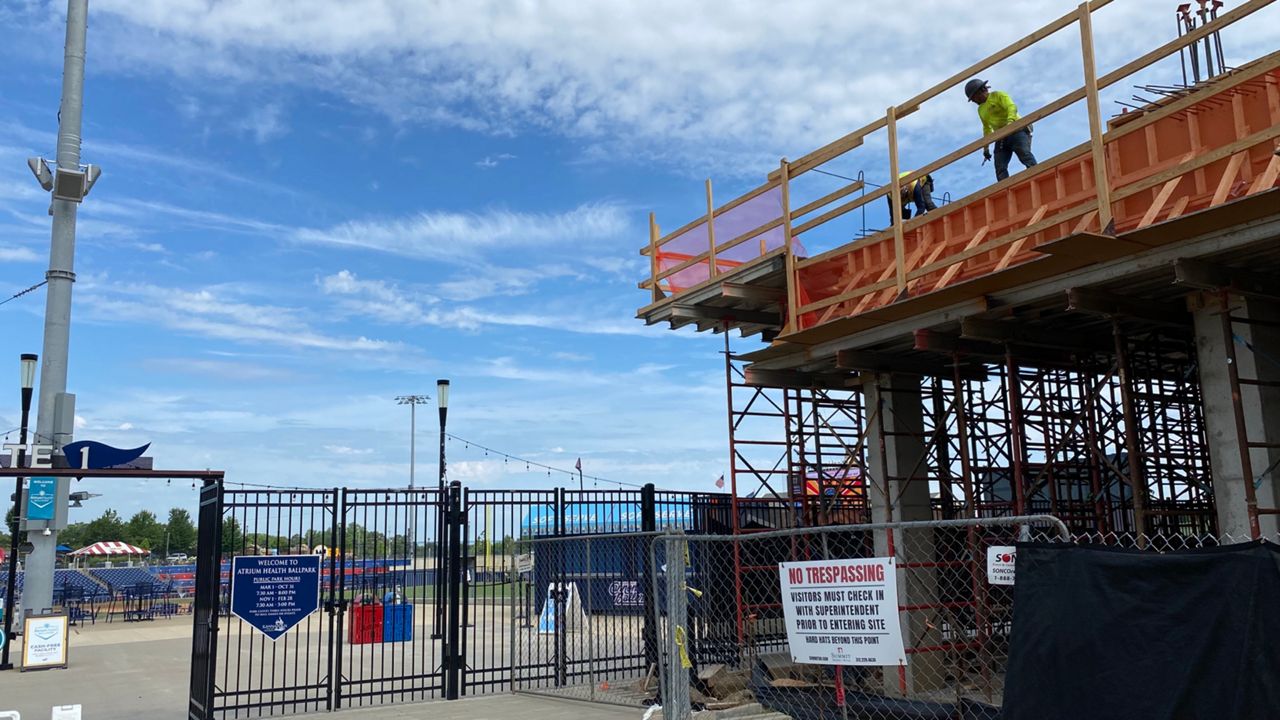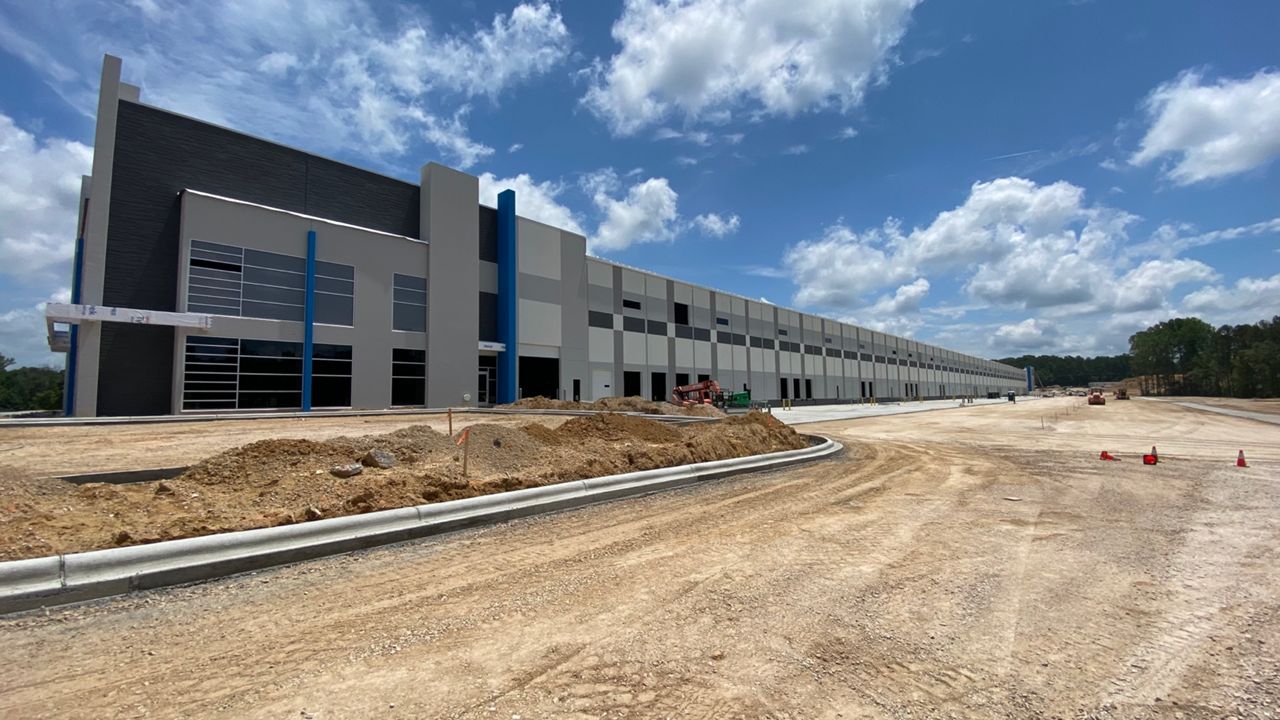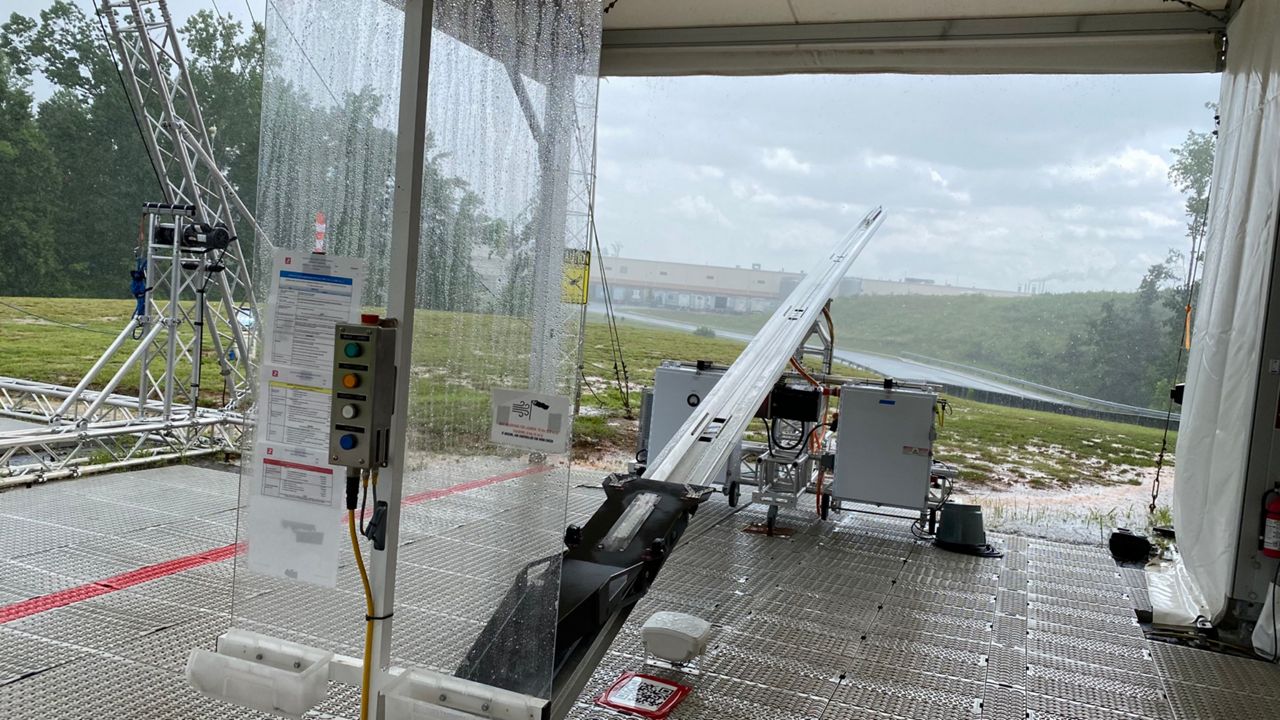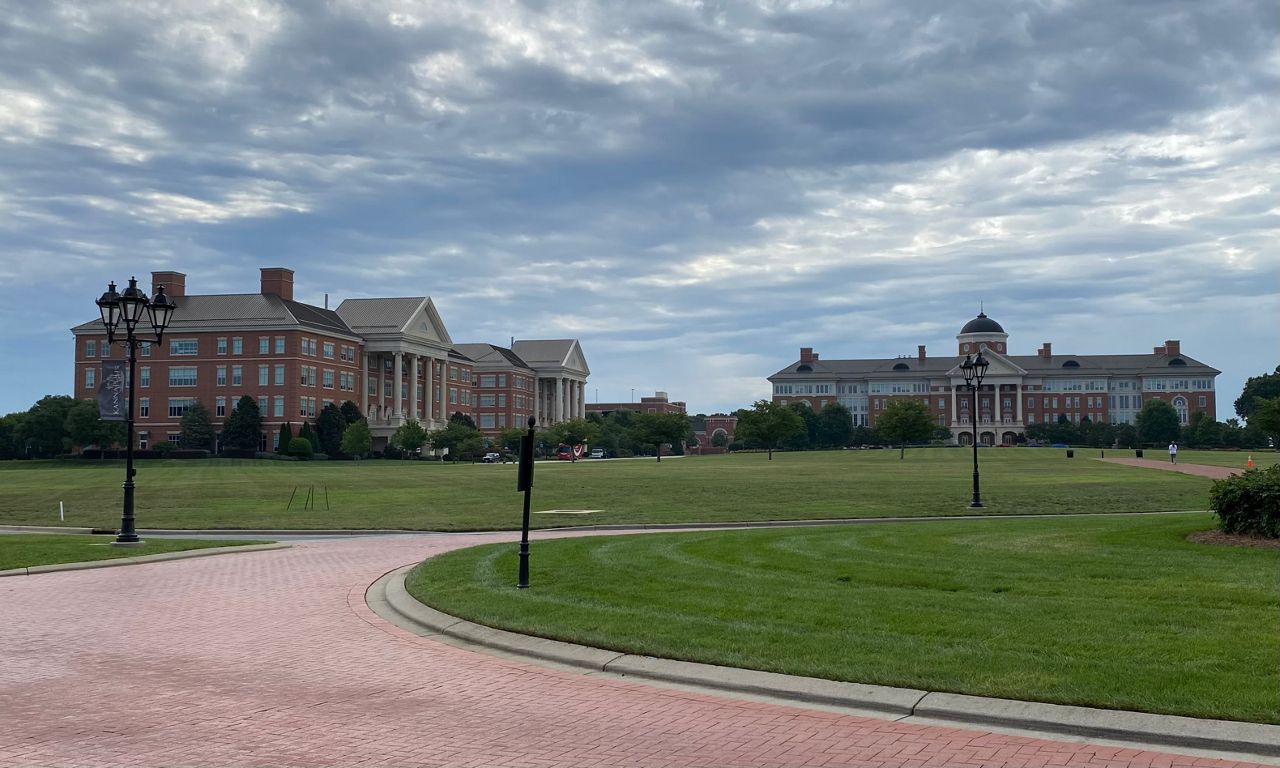KANNAPOLIS, N.C. — On a good night, more than 5,000 people will pack into the Atrium Health Ballpark, home of the Kannapolis Cannon Ballers. The minor league baseball team is a Single-A affiliate of the Chicago White Sox, but their presence here in a brand new downtown ballpark is more than a training ground for major league hopefuls. It’s a symbol of where the city has been and where it’s going.
The ballpark sits in downtown Kannapolis, between the growing commercial center of the city and the sprawling research campus. On a recent summer morning, people out for exercise walked laps around the stands as children played on a massive jungle gym off the third base line and a crew worked on manicuring the pitcher’s mound.

All of this, the North Carolina Research Campus, the ballpark, City Hall, was once a sprawling 6 million-square-foot textile mill. The mill was originally owned by Cannon Mills, where the city got its name, and later owned by Pillowtex. But those days are long gone.
Kannapolis (once known informally as Cannon-opolis) is about 20 miles north of Charlotte and is the site of the largest single layoff in North Carolina history. When Pillowtex filed for bankruptcy and shuttered the plant in 2003, 4,000 people lost their jobs here in one day.
The factory, once the single biggest textile mill building in North America, is gone. In its place is a city doing the hard work and making serious investments to revitalize and chart a new course.
Folks in Kannapolis City Hall are quick to tell newcomers that this was the largest unincorporated community in North Carolina when it was finally incorporated in 1984. This was a mill town. The Cannon Mills factory, worker housing and amenities surrounding the plant were Kannapolis.
Kannapolis straddles the border between Cabarrus and Rowan counties. The mill began production in 1908 and quickly became the world’s biggest producer of towels and sheets.
Mayor Darrell Hinnant, a chemist by trade, started working at the mill in 1973 and moved to the unincorporated city two years later. He did not work for Cannon Mills, but his job was supplying all the chemicals needed to help keep the plant going, for treating water and sewage, and keeping the air conditioners and boilers working.
“When I was first working here in 1973, Kannapolis was all about the mill,” Hinnant said. The company would bus in thousands of people from surrounding communities to work at the mill.
“At shift change it was gridlock downtown,” he recalled. He said people in the area would drop out of school at 16 to come work at the mill.

The community had 1,600 homes, a civic center, movie theater, a YMCA and a temporary hospital, according to the city’s official history. They were all built by the mill for workers.
When the city incorporated in 1984, the plant had 30,000 employees. By then it was owned by the Pacific Holding Company and David Murdock, and later, in 1997, sold to Pillowtex. But by then the textile industry was already moving offshore.
The factory closed in 2003, laying off the 4,300 workers still remaining. City leaders had a problem: What do they do now?
The 6 million-square-foot mill, bigger than the Pentagon, sat as an empty centerpiece of Kannapolis.
Murdock, who by then owned Dole Foods, returned to Kannapolis in 2004 and bought the mill property, which included much of the city, at auction.
That’s the same year Kannapolis hired Mike Legg as its new city manager, a post he still holds today.
“The leadership of this community said, if we don’t do something bold, nothing is going to happen,” Legg said in a recent interview, standing amidst the towering buildings and spacious lawns that now dominate where the Cannon Mills factory once stood.
The mill came down in 2004, and Murdock announced plans for a $1.5 billion research campus right in the center of town. That was the first in a series of big dreams for this little city, and it worked.
Where the mill once stood, the North Carolina Research Campus now houses labs for professors from Duke, N.C. State, UNC-Chapel Hill and half a dozen other universities.

The campus is spread over 350 acres and includes the NC Food Innovation Lab. Rowan-Cabarrus Community College has two-year degree programs there in biotechnology and nursing. City Hall and the police department occupy much of one of the buildings.
The new ballpark looks out over the campus, and the city’s little downtown sits next to the new stadium.
“It was hard to get some people to come because downtown was all boarded up,” Hinnant said. “When all those people disappeared, our downtown disappeared.”
Murdock has his money tied up in the research campus, so the city had to decide what to do with its desolate downtown.
“The city council and I have had to make lots of very bold decisions,” the mayor said. “You had to be bold to buy your entire downtown.”
But about seven years ago, that’s just what they did.
One story Hinnant tells is about going down to the General Assembly in Raleigh. Legislators said to him: “‘Mayor, you’re sort of like the dog who chases the bus. Now that you’ve got it, what are you going to do with it?’ That was the next very bold decision that we had to make.”
The city started renovating the downtown and selling off the properties, aiming to bring in new business to support a downtown core. But, the mayor said, the downtown needed something big.
“When the community says to you, we want you to devise something that will make an active downtown, you say to yourself, does that include spending $54 million to build a baseball stadium?” Hinnant said.
Yes it did. The city worked with the Kannapolis Cannon Ballers and Minor League Baseball to move the team from a ballpark out near Interstate 85 and put them right in the middle of town.
“The leadership of this community said, if we don’t do something bold, nothing is going to happen,” Legg, the city manager said.
Those bold moves appear to have paid off. Kannapolis is growing. Between 2010 and 2020, the city grew from 42,625 people to 53,114, according to the U.S. Census Bureau.
The goal now, city leaders say, is to get a good mix of jobs and housing options for more people to call Kannapolis home.

The city has an advantage by being in Charlotte’s orbit, and having less expensive housing close to I-85 for people who want to commute into the city. There’s a new highway in the works, too, that will help link the Queen City to Kannapolis for commuters.
There are also job centers in neighboring Concord and Salisbury. It’s not just all fancy research and tech jobs on the Research Campus. North Carolina is seeing a manufacturing boom around the state, and developers are hoping they can turn some of this empty land in Kannapolis to tap into that demand for more factories and distribution centers.
About 10 minutes outside downtown, just off Exit 63 on I-85, workers are putting the finishing touches on Metro 63. It’s a brand new 755,000-square-foot building, almost ready to house North Carolina’s next factory or shipping center.
“The big factors for warehouse development is proximity to the interstate, proximity and access to the labor pool, access to other manufacturers in the area,” said Tom Tropeano, a vice president with Avison Young, the company marketing the new development.
“We’ve seen a huge growth of industrial developments and other companies come up this I-85 corridor,” he said.
“What we love about this part of the I-85 corridor outside of Charlotte is that it does have this really good labor story, generational,” said Henry Lobb, also with Avison Young.
“You had that huge textile impact, which still has a lot of that legacy labor in this area. These companies that look for manufacturing facilities, distribution facilities, that labor viability is really important for them,” Lobb said.
Metro 83 is one of three big industrial developments underway around Kannapolis. Another is at the old baseball stadium site near the interstate.
“We will see more industrial development here than in the last 100 years when Cannon Mills started construction in 1906,” the city manager said.
South of downtown, in an industrial park off a big main road, sits an odd amalgamation of converted shipping containers. A pharmacist works in one. Others house the controls for a handful of drone pilots. Out back, out of view from most passers-by, is the launch center for Zipline, a drone delivery service.

A metal bar rises out over a clear area, a catapult of sorts for drone delivery, similar to how planes take off from the flight deck of an aircraft carrier. Next to the launch area, a metal frame serves as the landing pad, with a strap the drones catch with a hook as they come back into home base.
Much of Zipline’s business so far has been delivering medicines and vaccines in Africa. In the United States, the company has operations in Arkansas and North Carolina. Zipline started flying outside of Charlotte in 2020 through a deal with Novant Health to test drone deliveries here.
The drones can fly a 100-mile round trip and drop their deliveries with parachutes attached to small boxes that can hold up to 4 pounds.
“We just began flying commercially there in June,” said Zipline general counsel Conor French. “We had previously worked with Novant help on pandemic response, being able to deliver many units of personal protective equipment to frontline health workers in the Charlotte metro area.”
The company is now moving into larger-scale commercial operations, he said.
Drone delivery feels like a futuristic idea for many. But in North Carolina, it’s starting from an industrial park in Kannapolis. That seems fitting for a city that dreams big.

But with big dreams come challenges, for a company doing drone delivery or a city working to bring life back to an old mill town.
Back at City Hall, the question is, what comes next?
“We have so many things going right now, we decided to ask ourselves a very good question: What do we want to be when we grow up? That is, in 10 years, 15, 20 years from now, what do we want to be known as here in Kannapolis?” Hinnant, the mayor, said.
Downtown is coming back to life. The new baseball stadium is attracting thousands of people. The city even became one of the first in North Carolina to create a social district, allowing public drinking in the downtown core.
“We’re trying to image what the impact of our community is going to be on our citizens and on the surrounding communities too, four of five years, 10 years down the road, everything from housing to homelessness to historic preservation, to community development,” the mayor said.
City government has to do more than revitalize downtown. It has to make sure the streets get repaired, that there are enough police and firefighters, that residents have things like parks and playgrounds.
“This is an opportunity to step back and say ‘what comes next?’” said Legg, the city manager.
The city is launching what it’s calling Imagine Kannapolis, a new strategic planning process to help answer that question: What do you want to be when you grow up?
Growth is coming, there’s no doubt about that for city leaders. Charlotte’s suburbs keep expanding and so do the job opportunities in Kannapolis itself.
“We’ve had growth over the past 20 years, but we’re at the cusp of big growth,” Legg said. “I think that’s more of a shock to our system than other communities.”
The city is recruiting residents to join what it’s calling “focus groups” to help shape a vision for the future of Kannapolis, starting with five main topics: historic preservation, environmental stewardship, neighborhood improvement, homelessness and transitional housing, and recreational facilities.
“Generally downtown has got its own path now,” Legg said. So it’s time for the city to turn its attention out from the downtown core.
“We really need to focus on job creation and well-paying jobs to create wealth in our community, the opportunity to create wealth in our community,” he said.
Kannapolis has spent the better part of two decades dreaming big and making those dreams happen. There are lots of outside forces that could get in the way, like a global recession or big hits to Charlotte’s economy. But the city is getting ready to figure out its next set of dreams — then it’s up to the community and city leaders to make them a reality.





